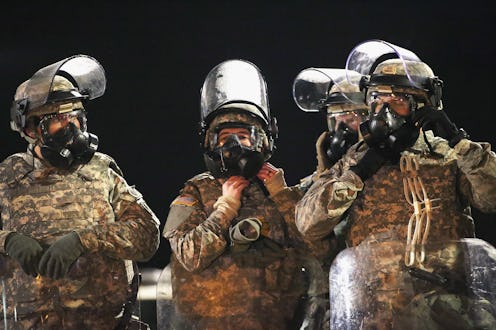News
What Impact Does The National Guard Have?
As violence escalated in Baltimore Monday night, Maryland Gov. Larry Hogan declared a statement of emergency and called in the National Guard, The New York Times reported. But can the National Guard help Baltimore? National Guard troops are called in to help quell violence and maintain civil order. Some units arrived Monday night, with others set to touch down on Tuesday.
Governors can rely on the National Guard when there are conditions of extreme unrest or emergency situations where residents could be in danger. The National Guard can also be asked to help with disasters like floods and hurricanes, but it's becoming more and more common for them to be brought in when local police can't manage crowd control, such as in Baltimore on Monday and in Ferguson, Missouri, last summer. Gov. Jay Nixon called in Missouri's National Guard when protests turned violent after a grand jury chose to not indict white police officer Darren Wilson in the shooting death of Michael Brown. Ferguson, which has a population of 20,000 people, had some 2,000 troops attempt to get the violence under control.
There's no question it can be helpful to have people with military training assisting when there is a crisis situation such as a natural disaster. But what if the problems that warrant the National Guard's presence in a community arise from an incident with a police officer or police violence? It can end up having repercussions that worsen the situation than improve it.
Selma, Alabama, In 1965
President Lyndon Johnson called in the National Guard after protesters in a civil rights march were attacked by local police armed with billy clubs and tear gas. The march was to protest the killing of Jimmie Lee Johnson by an Alabama state trooper. The president stepped in after Gov. George Wallace declined to use state National Guard troops to protect the protesters, CNN reported.
Detroit In 1967
After a police raided a bar in Detroit, violent protests broke out, according to NBC News. President Johnson and Michigan Gov. George Romney ordered in the National Guard, which at one point had 8,500 troops in the city and were under command of the Army. Fires burned all over Detroit, and 43 people were killed.
Los Angeles In April 1992
The National Guard in California were called into Los Angeles in 1992, when violent protests began after white officers were acquitted in the beating of black man Rodney King, an incident that was one of the first widely publicized examples of police violence that was caught on video. After nearly a week of rioting and looting, more than 60 people were dead and some 2,000 people had been injured, according to the Los Angeles Times. The first round of troops was not able to stop the violence, and a second round was called in. Before the violence was over, the Marines had also been brought in, and L.A. officials were widely criticized for their slow response to the smoldering anger, according to the LA Times.
Seattle In 1999
Thousands of "anarchists" took over the downtown Seattle area, causing damage to buildings and police cars, the Seattle Post-Intelligencer reported. They were protesting the gathering of members of the World Trade Organization, which were set to arrange global trade agreements. While the protests were initially not violent, Mayor Paul Schell eventually declared a state of emergency, and Gov. Gary Locke ordered National Guard troops to be sent in. There were more than 150 arrests, the P-I reported, and eventually Seattle's police chief resigned, accepting blame for how badly things were handled.
Images: Getty Images (4)
